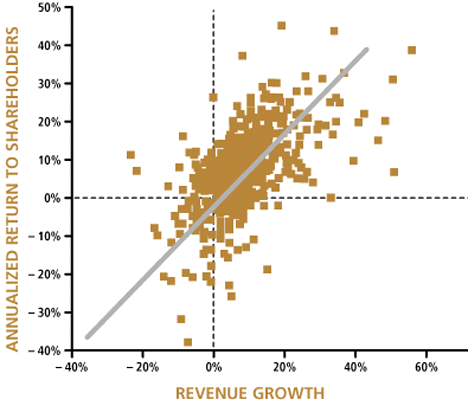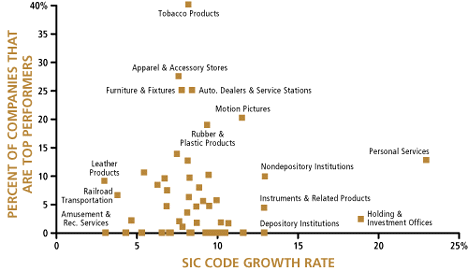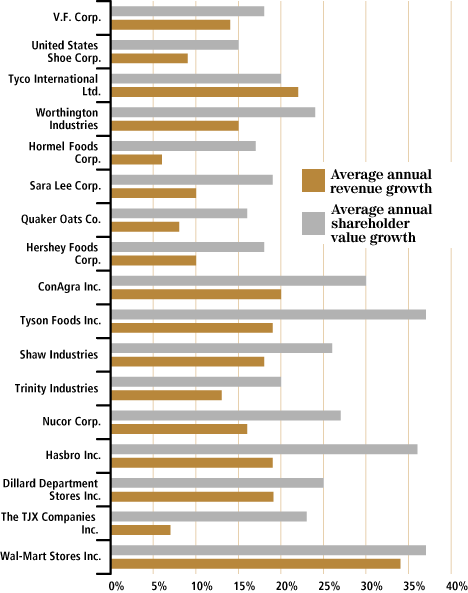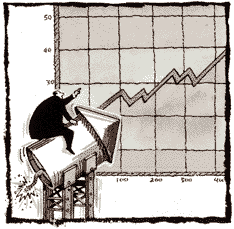Toward a New Theory of Growth
The old model, which says revenue growth and shareholder-value growth are correlated, does not go far enough toward explaining how the best companies create value. It ignores the formidable concept of strategic innovation.
Dismissing the conventional wisdom linking revenue growth and shareholder value as only partially accurate and potentially misleading, the authors advance preliminary ideas on a new theory of growth - part of an ongoing research effort at Booz-Allen & Hamilton. In fact, they identify two fundamentally different paradigms, calling them Managed-Growth and Innovative-Growth.
Managed-Growth focuses on achieving market and cost positions superior to competitors through better planning and management to achieve commendable if not spectacular shareholder value. General Electric Co., with a 12 percent annual return over the past decade, is cited as an excellent example.
Innovative-Growth leverages strategic innovation, or a stream of product innovation, to drive growth in profitability. Innovative companies specialize in being different from their competitors - strategically or productwise - and customers perceive them to be of significantly superior value. Examples of strategic innovators trading on their differences include Wal-Mart, Microsoft, Southwest Airlines, Tyson Foods and The Gap. San Francisco-based The Gap is spotlighted in a case study accompanying the article.
With an unwavering commitment to be the best, an exceptionally motivated workforce, and rapid improvements in their growth engines, Innovative-Growth companies consistently dominate the top 25 percent in terms of returns to shareholders. Questions remain, however. Are Innovative-Growth companies inherently riskier? Do Managed-Growth companies sustain their superiority over a longer time? The research continues.
A new conventional wisdom is emerging about growth. It says that after restructuring to increase short-term shareholder value by reducing costs, companies should then focus on creating long-term shareholder value by growing revenues. Revenue growth, in turn, is achieved by pursuing growing market segments, by finding new customers and by improving the retention of existing customers. The link between revenue growth and shareholder-value growth is viewed as causal and direct.
Unfortunately, our research suggests that the new conventional wisdom is only partly accurate and that it is potentially misleading, especially in its managerial implications. The aim of this article is to correct some misunderstandings and advance some preliminary hypotheses that may lead to a new theory of growth. It is part of a larger, ongoing research effort at Booz-Allen & Hamilton aimed at uncovering the real dynamics of growth and the creation of value. These preliminary conclusions are based on case studies and an analysis of 1,828 companies listed on American stock exchanges with market capitalizations of more than $500 million in 1994 dollars. The time frame of the analysis is between 1974 and 1994, and relies on data from the University of Chicago Research Project on Stock Prices.
UPDATING CONVENTIONAL WISDOM ON GROWTH
Our research indicates that the new conventional wisdom falls short in at least three respects. In the first regard, the data indicate that revenue growth is only moderately related to the creation of shareholder value:
- In the short term, the data show that there is no relationship between revenue growth and shareholder-value creation. This finding is not in contradiction with the new conventional wisdom.
- In the longer term of 10 years, however, contrary to the new conventional wisdom, the data show (see Exhibit I) that there is only a moderate correlation between revenue growth and the creation of shareholder value.
1985-1994 REVENUE GROWTH VS.
ANNUALIZED RETURN TO SHAREHOLDERS

- R squared = 0.32
- Regression coefficient range 0.50 to 0.62 (95% confidence)
At best, the data suggest that the relationship between revenue growth and growth in shareholder value--defined as increases in stock price plus dividends, adjusted for stock splits--is not a close one. In reality, many companies (see Exhibit II) have been successful in creating shareholder value with only modest growth in revenues while several fast-growing companies have not delivered value to their shareholders. Our analysis suggests that revenue growth, over a decade, explains only about one-third of the variation in long-term shareholder-value creation.
| EXHIBIT II: SELECTED EXAMPLES, 1985-1994 Fast top line, Slow bottom line |
||
|---|---|---|
| Company | Revenue Growth (%) |
Annual Return to Shareholders (%) |
| Immunex | 51 | 7 |
| Quantum Corp. | 39 | 10 |
| AST Research Inc. | 33 | (1) |
| Comcast Corp. | 28 | 5 |
| Marion Merrell Dow | 26 | 7 |
| EXHIBIT IIA: SELECTED EXAMPLES, 1985-1994 Fast bottom line, Slow top line |
||
|---|---|---|
| Company | Revenue Growth (%) |
Annual Return to Shareholders (%) |
| SunAmerica | (1) | 26 |
| Crompron & Knowles | 10 | 26 |
| Cooper Tire & Rubber | 10 | 25 |
| Gillette | 10 | 25 |
| Fannie Mae | 6 | 24 |
This analysis of the first premise prompts us to ask the following two questions: If revenue growth and shareholder value are only moderately linked, what really drives gains in shareholder value--what is the real engine of growth? And, if revenue growth is not the cause of shareholder value, could gains in revenue instead be the result of strategies that create shareholder value? These are questions we hope to answer.
In the second regard, our analysis shows that the new conventional wisdom falls short for another reason. Industry growth rates are almost completely unrelated to the likelihood that a company will be able to create superior value for shareholders over a 10-year period. Exhibit III shows the relationship between the proportion of companies in an industry with superior returns to shareholders and the growth rate for 50 industries. Contrary to what might be surmised, an analysis of the data shows that companies in slow-growing, mature industries are somewhat more likely to create superior returns for shareholders than companies in fast-growing industries (see Exhibit IV). As might be expected, few companies in declining industries create superior shareholder value.
CORRELATING SUPERIOR PERFORMANCE
WITH INDUSTRY GROWTH RATES

- R squared = 0.00
- Two digit S.I.C. codes used to classify industries
- 15 S.I.C. codes excluded due to lack of data. This resulted in elimination of 5.3% of companies
- Growth rates derived from years 1972-1987
Source: University of Chicago (C.R.I.S.P.), D.R.I., Booz-Allen & Hamilton analysis
The third premise of the new conventional wisdom also falls short. The tactics implied by the new conventional wisdom--new markets, new customers, better customer retention, higher prices--at best result in growth rates that are a few percentage points faster than the industry. Though companies employing these tactics performed somewhat better than average over the long term of a decade, the best performing 20 percent of companies we studied grew shareholder value and revenue at more than double the average rate. (Exhibit IV) If superior tactics are not enough to propel companies into the ranks of the top-performing firms, what is needed? How can such rapid growth be achieved?
1974-1994 SELECTED EXAMPLES OF FAST-GROWING COMPANIES
IN INDUSTRIES GROWING LESS THAN 7% ANNUALLY

TOWARD A NEW THEORY OF GROWTH
The data lead us to formulate a new--albeit still tentative--hypothesis. It is that companies create long-term shareholder value by using one of two fundamentally different paradigms--paradigms grounded in different management philosophies, with different levels of risk and with different potentials for reward. We call these two approaches the Managed-Growth Paradigm and the Innovative-Growth Paradigm. This is how they differ:
- The Managed-Growth Paradigm focuses on achieving market and cost positions superior to competitors through better planning and management. Using the managed-growth paradigm, companies are able to achieve very good (but not outstanding) shareholder-value creation.
- The Innovative-Growth Paradigm leverages strategic innovation or a stream of product innovation to drive growth in profitability and revenue for 5 to 20 years. Our preliminary findings indicate that the companies that achieve the greatest growth in value for their shareholders pursue growth through two major variations of this paradigm.
The new conventional wisdom about growth is generally consistent with our notion of the Managed-Growth Paradigm. Our analysis departs from the new conventional wisdom, however, in that we find that the companies that achieve the greatest returns for their shareholders are not simply executing the managed-growth paradigm more effectively--they are operating outside of it.
THE MANAGED-GROWTH PARADIGM
The General Electric Company is a superbly managed company operating within the boundaries of the Managed-Growth Paradigm. It provides a good benchmark for the upper bound of possible success utilizing this strategy. During the past decade, G.E.'s shareholders had an average annual return of 12 percent (4 percentage points more than the market average) while revenue grew at an annual rate of 9 percent (1 point more than the market). During the 14 years that Jack Welch has been C.E.O., G.E. shareholders have received an average annual return of 16 percent (6 points more than the market).
G.E.'s performance demonstrates that outstanding success in the Managed-Growth Paradigm yields returns to shareholders in the 75th percentile. Few companies operating in the Managed-Growth Paradigm can expect to do better. So what are the hallmarks of the best companies operating in this paradigm, as exemplified by G.E.?
The most successful undertake to do the following:
- Drive large increases in labor and asset productivity year after year through a combination of re-engineering and continuous improvement programs.
- Set stretch targets for both revenue and profit growth that force managers to try to gain market share and to apply new methods to reduce costs.
- Stimulate early identification and prosecution of new market opportunities whether in new geographies or adjacent customer segments.
- Seize strategic opportunities to capitalize on changes in industry or to make critical acquisitions or divestments.
Superior performance in this paradigm rests upon advantaged assets, a better planning process and more effective managers; its risk profile is generally low.
THE INNOVATIVE-GROWTH PARADIGM
 In the Innovative-Growth Paradigm, a company does something that is different from its competitors and that its customers perceive to be of significantly superior value. By sharing part of its superiority with its customers, generally in terms of better value, and by capturing the rest as profitability, a successful company in the Innovative-Growth Paradigm simultaneously creates rapid growth in revenue, profit and shareholder value. The "something different" at the heart of the paradigm--the growth engine--can be either a strategic innovation or a stream of product innovations, or both.
In the Innovative-Growth Paradigm, a company does something that is different from its competitors and that its customers perceive to be of significantly superior value. By sharing part of its superiority with its customers, generally in terms of better value, and by capturing the rest as profitability, a successful company in the Innovative-Growth Paradigm simultaneously creates rapid growth in revenue, profit and shareholder value. The "something different" at the heart of the paradigm--the growth engine--can be either a strategic innovation or a stream of product innovations, or both.
A strategic innovation engine involves a distinct approach to serving customers grounded in a more efficient and effective way of doing business. Wal-Mart, Microsoft, Southwest Airlines, Home Depot, The Gap, Tyson Foods, Shaw (in carpets) and Nucor are all examples of strategic innovators that have been successful in driving outstanding revenue and shareholder-value growth; they produced their superior results by doing something different from their competitors. In many instances, even after 5 or 10 years, their competitors were unable to duplicate their offerings and win back market share. While most of the cited examples are from single-business companies, strategic innovation can also happen at the business unit level. For example, the Frito-Lay division of PepsiCo Inc. appears to have had similar success even though the link to shareholder-value creation is less easy to demonstrate.
A product innovation engine results in a steady stream of superior new products or services. It does so by coupling an effective product development process with superior product concepts. The notion of a stream is critical: a single stroke of good luck in product development is not sufficient to generate superior returns to shareholders over a decade.
In some companies, the superior product concepts are based on competitively advantaged technology, e.g., Merck, Intel or Boeing. Still other companies develop superior concepts from their deeper insights into customers. Levi Strauss, Intuit and Nike, for example, understand the entire customer experience, broadly and deeply. Intuit, for example, is able to capture, use and leverage its customers' questions. These questions ultimately lead the company into a deeper understanding of its customers' unmet needs, which, in turn, leads to product changes and new product offerings.
In addition to a strategic, product or customer-insight growth engine, our preliminary findings suggest that the most successful companies in the Innovative-Growth Paradigm share the following attributes:
- Leaders with an unwavering commitment to being the absolute best (not just "second to none"), who are willing to bet the company and are intimately involved in the constant renewal of the growth engine.
- Rapid improvements in the growth engine, both through periodic leapfrogs and doing better every day.
- An exceptionally motivated work force, not just as a result of success but also as an integral element of success. Strategic innovators seem to cultivate an almost messianic zeal in their work force.
- A defined growth trajectory. Few companies are able to drive rapid revenue growth for 10 to 15 years within their initial market segments. Each successful company seems to choose one principal source of growth. Geographical expansion is the most frequent growth trajectory: for example, regional expansion for retailers or globalization (see "Global Cosmopolitans" by Rosabeth Moss Kanter, on the Gillette Company, in Issue 1 of Strategy & Business). Companies like Newell, Browning-Ferris and Valspar illustrate the second most frequent growth trajectory: a series of acquisitions that are so well assimilated that they immediately increase both revenue and shareholder value.
It should come as no surprise that companies pursuing the Innovative-Growth Paradigm should achieve superior growth in revenue and shareholder value: each company in this group is well-known to investors and to competitors in its industry. There has been one major surprise in our research, so far: That while companies in the Innovative-Growth Paradigm differ in industry, and to some extent approach, they consistently dominate the top 25 percent in terms of returns to shareholders. In other words, the data confirm that superior strategies actually produce superior results, and that these results are measurable.
MANAGEMENT IMPLICATIONS--SO FAR
 There are a number of managerial implications--as well as questions--that come from this line of research. Discussions of these preliminary findings with C.E.O.'s at some of the largest and most successful companies have raised the following questions:
There are a number of managerial implications--as well as questions--that come from this line of research. Discussions of these preliminary findings with C.E.O.'s at some of the largest and most successful companies have raised the following questions:
- Is the Innovative-Growth Paradigm inherently riskier than the Managed-Growth Paradigm?
- Do companies that successfully pursue the Managed-Growth Paradigm sustain their superiority for a longer time?
- How are companies in the Innovative-Growth Paradigm able to sustain their superiority for 10 to 15 years since they do not enjoy the advantages that economists traditionally think of as competitive barriers?
- Is the Innovative-Growth Paradigm feasible for all companies, or only companies in certain situations?
There are other questions as well that we can answer only with further research. As a result, we will continue to pursue our research in these areas. However, managers can with confidence draw four implications from this research:
- Companies in virtually every industry have the potential to create superior long-term returns for their shareholders.
- Companies can choose either of two fundamentally different paradigms for achieving long-term growth in shareholder value: managed growth and innovative growth.
- The paradigms differ in their success requirements, their expected results and their risks. Each paradigm is best for some companies.
- Although revenue growth is correlated with long-term shareholder-value creation, the causal relationship is different in the two paradigms:
- In the Managed-Growth Paradigm, greater managerial focus on increased revenue (without losing the commitment to enhanced productivity) should create increasing value to shareholders--potentially up to returns in the 75th percentile.
- The greatest long-term returns to shareholders require innovative growth. In this paradigm, by focusing on sustaining their growth engines, managers simultaneously achieve growth in revenues and shareholder value.
ONGOING EFFORTS
This report has laid out some elements in our ongoing examination of issues relating to growth and strategy. We are continuing this research on a more detailed level to examine more deeply the question of strategic innovation and product and service innovation. The aim of the program is to rethink the brief on strategy and growth and to calibrate this thinking using such "hard" measures as gains in shareholder value as well as various accounting measures.
So far, using our database and case studies, we have already tested--and discarded--a number of suppositions. We will continue to do so until our new theory of growth is sufficiently broad and complete. When these research efforts yield new insights, we will make them available in published form.
The Gap Inc. as Strategic Innovator
When Donald G. Fisher, chairman and chief executive of The Gap Inc., opened his first blue jeans store in San Francisco, his goal was growth. The means he has used to pursue that end have always been innovative. For most of its history, The Gap has been a leader in shifting clothing purchases away from department stores, in providing high-quality clothing at affordable prices and in the use of new formats to prod growth.
The foundation of The Gap's success has been its merchandising. Guided by the expertise of Millard S. Drexler, The Gap's president and chief operating officer, the company has more frequent seasonal stock changes than traditional department stores and most other specialty retailers. More clothing seasons to the year enable The Gap to constantly react to changing consumer needs and to draw customers into its stores to see what is new. As a consequence, The Gap is able to give customers more of what they want, when they want it. The result is that it is less dependent than other retailers on price reductions to move its merchandise.
The Gap has also been a pioneer at using new store formats to move products. Its formats include GapKids, BabyGap and Old Navy and Banana Republic--which it purchased and then revitalized. The company's GapScents and GapShoes are its newest formats. This wide variety of formats is vital to the company's ability to keep up with its customers' changing needs. With its current line of formats, the company expects to sell across most of the major price/value segments of the family clothing market. But that is not all. The Gap has also been very active bringing new product lines, such as accessories, into its existing store formats.
These new store format expansions took place while The Gap was growing its base business. For example, from 1984 to 1994, when it was creating its new formats, the company expanded from 623 stores to 1,384 in the United States. At the same time, it began to compete internationally with stores in Britain, Canada, France, Germany and Japan.
The Gap has an especially talented work force that it values highly and treats well. For the most part, it promotes from within. One of The Gap's goals has been the enhancement of its employees' performance and the improvement of its employees' level of satisfaction. To do that, The Gap encourages good communications between people at all levels within the company. It also provides employees with the resources they need to improve their skills and advance. The end result of all these efforts is a highly motivated, innovative organization that is almost completely aligned around Mr. Fisher's initial goal of growth. ![]()
Reprint No. 96103
Illustration by Bill Morrison
| Authors
Charles E. Lucier, lucier_charles@bah.com Chuck Lucier is a senior vice president and the chief growth officer of Booz Allen Hamilton. His client work focuses on strategy and knowledge issues for consumer products and health companies. Amy Asin, asin_amy@bah.com Amy Asin is a principal with Booz-Allen & Hamilton based in San Francisco. She plays a leadership role in identifying trends and best practices in post-merger integration. |




